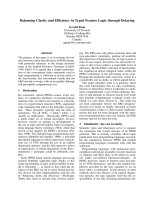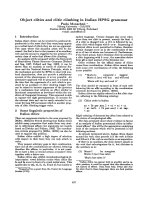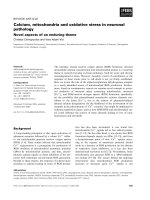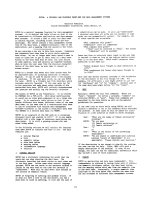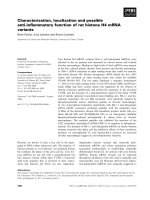Báo cáo khoa học: "Discourse Pragmatics and Ellipsis Resolution in Task-Oriented Natural Language Interfaces" pptx
Bạn đang xem bản rút gọn của tài liệu. Xem và tải ngay bản đầy đủ của tài liệu tại đây (469.36 KB, 5 trang )
Discourse Pragmatics and Ellipsis Resolution
in Task-Oriented Natural Language Interfaces
Jaime G.
Carbonell
Computer Science Department
Carnegie-Mellon University.
P!ttsburgh, PA 15213
Abstract
This paper reviews discourse phenomena that occur frequently
in task.oriented man.machine dialogs, reporting on a~n empirical
study that demonstrates the necessity of handling ellipsis,
anaphora, extragrammaticality, inter-sentential metalanguage,
and other abbreviatory devices in order to achieve convivial user
interaction. Invariably, users prefer to generate terse or
fragmentary utterances instead of longer, more complete "stand-
alone" expressions, even when given clear instructions tO the
contrary. The XCALIBUR exbert system interface is designed to
meet these needs, including generalized ellipsis resolution by
means of a rule-based caseframe method superior tO
previous
semantic grammar approaches.
1. A Summary of Task-Oriented
Discourse Phenomena
Natural language discourse exhibits several intriguing
phenomena that defy definitive linguistic analysis and general
computational solutions. However, some progress has been
made in developing tractable computational solutions to
simplified version of phenomena such as ellipsis and anaphora
resolution [20, 10, 211. This paper reviews discourse phenomena
that arise ~n task.oriented dialogs with responsive agents (such
as expert systems, rather than purely passive data base query
systems), outlines the results of an empirical study, and presents
our method for handling generalized ellipsis resolution in the
XCALIBUR expert system interface. With the exception of inter-
sentential metalanguage, and to a lesser degree
extragrammaticality, the significance of the phenomena listed
below have long been recognized and documented in the
computational linguistics literature.
• Anaphora Interactive task-oriented dialogs invite the
use of anaphora, much more so than simpler data base
query situations.
• Definite
noun phrases
As Grosz [6] noted, resolving
the referent of defimte noun phrases requires an
understanding of the planning structure underlying
cooperative discourse,
• Ellipsis Sentential level ellipsis has long been
recognized as ubiquitous in discourse. However, semantic
ellipsis, where ellipsed information is manifest not as
syntactically incomplete structures, but as semantically
incomplete propositions, is also an important
phenomenon. The ellipsis resolution method presented
later in this paper addresses both kinds of ellipsis.
•
Extragrammatical utterances
Interjections, dropped
articles, false starts, misspellings, and other forms of
grammatical deviance abound in our data (as explained in
the following section). Developing robust parsing
techniques that tolerate errors has been the focus of our
earlier investigations [2, 9. 7] and remains high among our
priorities. Other investigations on error-tolerant parsing
incJude [13, 22].
• Meta.lincjuistic utterances Intra-sentential
metalanguage has been investigated to some degree
[18, 12J, but its more common inter-sententiai counterpart
has received little attention [4}. However, utterances about
other utterances (e,g,, corrections of previous commands,
such as "1 meant to type X instead" or "1 should have said
") are not infrequent in our dialogs, and we are making
an initial stab at this problem [8}. Note that it is a
cognitively less demanding task for a user to correct a
previous utterance than to repeat an explicit sequence of
commands (or worse yet, to detect and undo explicitly
each and every unwanted consequence of a mistaken
command).
• indirect speech acts Occasionally users will resort tO
indirect speech acts[19. 16, 1], especially in connection
with inter.sentential metalanguage or by stating a desired
state of affairs and expecting the system tO supply the
sequence of actions necessary to achieve that state.
In our prior work we have focused on extr~grammaticality and
inter.sentential metalanguage. In this paper we report on an
empLrical study of discourse phenomena to a s~mulated interface
and on our work on generalized elhpsis resolutLon in the context
of the XCALIBUR project,
2.
An Empirical Study
The necessity to handle most of the discourse phenomena
listed in the preceding section was underscored by an empirical
study we conducted to ascertain the most pressing needs of
natural language interfaces in interactive apl~lications, The initial
objective of this study was to circumscribe the natural language
interface task by attempting to instruct users of a simulated
interface not to employ different discourse devices or difficult
linguistic constructs. In essence, we wanted to determine
whether untrained users would be able to interact as instructed
(for instance avoiding all anaphoric referents), and, if so, whether
they would still find the interface convivial given our artificial
constraints.
The basic experimental set-up consisted of two remotely
located terminals linked to each other and a transaction log file
164
that kept a record of all interactions. The user wassituated at one
terminal and was told he or she was communicating with a real
natural language interface to an operating system (and an
accompanying intelligent help system, not unlike Wilensky's Unix
Consultant[23].) The experimenter at the other terminal
simulated the interface and gave appropriate commands to the
(real) operating system.
In different sessions, users were instructed not to use
pronouns, to type only complete sentences, to avoid complex
syntax, to type only direct commands or queries (e.g., no indirect
speech acts or discourse-level metalinguistic utterances [4, 8]),
and to stick to the topic. The only instructions that were reliably
followed were sticking to the topic (always) and avoiding
complex syntax (usually). All other instructions were repeatedly
violated in spite of constant negative feedback that is, the
person pretending to be the natural language program replied
with a standard error message. I recorded some verbal
responses as well (with users telling a secretary at the terminal
what she should type), and, contrary to my expectations, these
did not qualitatively differ from the typed utterances. The
significant result here is that users appear incapable or unwilling
to generate lengthy commands, queries or statements when they
can employ a linguistic device to state the same proposition in a
more terse manner. To restate the principle more succinctly:
Terseness principle:
users insist on being as terse
as possible, independent Of communication media or
typing ability. 1
Given these results, we concluded that it was more appropriate
to focus our investigations on handling abbreviatory discourse
devices, rather than to address the issue of expanding our
syntactic coverage to handle verbose complex structures seldom
observed in our experience. In this manner, the objectives of the
XCALIBUR project differ from those of most current
investigations.
3. A
Sketch of the ×CALIBUR interface
This section outlines the XCALIBUR project, whose objective is
to provide flexible natural language access (comprehension and
generation) to the XSEL expert system [15]. XSEL, the Digital
Equipment Corporation's automated salesman's assistant,
advises on selection of appropriate VAX components and
produces a sales order for automatic configuration by the R1
system [14]. Part of the XSEL task is to provide the user with
information about DEC components, hence subsuming the data-
base query task. However, unlike a pure data base query system,
an expert system interface must also interpret cnm"'~ndS,
understand assertions of new information, and carry out task-
oriented dialogs (such as those discussed by Grosz[6]).
XCALIBUR, in particular, deals with commands to modify an
order, as well as information requests pertaining to its present
task or itS data base of VAX component parts. In the near future it
should process clarificational dialogs when the underlying expert
system (i.e. XSEL) requires additional information or advice, as
illustrated in the sample dialog below:
>What is the largest 11780 fixed disk under $40,000?
The rp07-aa is a 516 M8 fixed pack disk that costs $38,000.
>The largest under $50,000?
The rp07-aa.
>Add two rpO7-aa disks to my order.
Line item 1 added: (2 ro07-aa)
>Add a printer with graphics capatJility
fixed or changeable font?
>fixed tont
lines per minute?
>make it at least 200, upper/lowercase.
Ok. Line item 2 added: (1 Ixyt 1-sy)
>Tell me about the Ixyl 1
The Ixyl 1 is a 240 I/m line printer with plotting capabilities,
With the exception of the system-driven clarification
interchange, which is beyond XCALIBUR's presently
implemented capabilities, the rest of the dialog, including the
natural language generation, is indicative of the present state Of
our system. The major contributions of XCALIBUR thus far is
perhaps the integratlon of diverse techmques into a working
system, including the DYPAR.II multi-strategy parser.
expectatnon.based error correction, case.frame ellipsis
USER
~ Oypar.II
Genet al,.:,r
]L~ 1 InformalLon
Manager
&
<_J
J'(-
XSEL
Long te,m (Static) Database
XCALIBUR
>
R1
i
Figu re 3-1 : Overview of XCALIBUR
llndicative as these empirical studies are of where one must
focus one's
efforts in developing convivial interfaces, they were not performed with adeqgato
control groups or statistical rigor. Therefore. there is ample room to confirm.
refute or expand upon lhe detads of our emoirical findings. However. the
surprisingly strong form in which Grice's maxgm [5] manifests itself in
task-
oa~ented
human computer d=alogs seems qualitatively irrefutable.
resolution and focused natural language generation. Figure
3.1 provides a simplified view of the major modules of
XCALIBUR, and the reader is referred to [3] for further
elaboration.
3.1. The Role of the Information Handler
When XSEL is ready to accept input, the information handler is
165
passed a message indicating the case frame or class of case
frames expected as a response. For our example, assume that a
command or query is expected, the parser is notified, and the
user enters
>What is the price of the 2/argest dual port fixed media disks?
The parser returns;
[QUERY (OBJECT (SELECT
(disk
(ports (VALUE (2)))
(disk-pack-type (VALUE (fixed)))
(OPERATION (SORT
(TYPE ('descending))
(ATTR (size))
(NUMBER (2)))
(PROJECT (price)))
(INFO-SOURCE
('default))
]
Rather than delving into the details of the representation or the
manner in which it is transformed prior to generating an internal
command to XSEL, consider some of the functions of the
information handler:
• Defaults must
be
instantiated.
In
the example, the query
does not explicitly name an INFO.SOURCE, which could be
the component database, the current set of line.items, or a
set of disks brought into focus by the preceding dialog.
• Ambiguous fillers or attribute names must be resolved. For
example, in most contexts. "300 MB disk" means a disk
with "greater than or equal to 300 ME]" rather than strictly
"equal to 300 MB", A "large" disk refers to ample memory
capacity in the context of a functional component
specification, but to large physical dimensions during site
planning, Presently, a small amount of local pragmatic
knowledge suffices for the analysis, but. in the general
case. closer integration with XSEL may be required.
• Generalized ellipsis resolution, as presented below, occurs
within the information handler.
As the reader may note, the present raison d'etre of the
information manager ts to act as a repository of task and dialog
knowledge providing information that the user did not feel
necessary to convey explicitly. Additionally. the information
handler routes the parsed command or query to the appropriate
knowledge source, be it an external static data base, an expert
system, or a dynamically constructed data structure (such as the
current VAX order). Our plans call for incorporating a model of
the user's task and knowledge state that should provide useful
information to both parser and generator. At first, we intend to
focus on stereotypical users such as a salesperson, a system
engineer and a customer, who would have rather different
domain knowledge, perhaps different vocabulary, and certainly
different sets of tasks in m,nd. Eventually, refinements and
updates to a default user model should be inferred from an
analysis of the current dialog [17].
4.
Generalized Caseframe Ellipsis
The XCALIBUR system handles ellipsis at the case-frame level.
Its coverage appears to be a superset of the LIFER/LADDER
system [10, 11 ] and the PLANES ellipsis module [21 ]. Although it
handles most of the ellipsed utterances we encountered, it is not
meant to be a general linguistic solution to the ellipsis
phenomenon.
4.1. Examples
The following examples are illustrative of the kind of sentence
fragments the current case-frame method handles. For brevity,
assume that each sentence fragment occurs immediately
following the initial query below.
INITIAL QUERY: "What is the price of the three largest
single port fixed media disks?"
"Speed?"
"Two smallest?."
"How about the price of the two smallest"
"also the smallest with dual ports"
"Speed with two ports?"
"Disk with two ports."
In the representatwe examples above, punctuation is of no help,
and pure syntax is of very limited utility. For instance, the last
three phrases are syntactically similar (indeed, the last two are
indistinguishable), but each requires that a different substitution
be made on the preceding query. All three substitute the number
of ports in the original SELECT field, but the first substitutes
"ascending" for "descending" in the OPERATION field, the
second subshtutes "speed" for "price" in the I~ROJECT field, and
the third merely repeats the case header of the SELECT field.
4.2. The Ellipsis Resolution Method
Ellipsis ~s resolved differently in the presence or absence of
strong discourse expectations. In the former case, the discourse
expectatmon rules are tested first, and, if they fad to resolve the
sentence fragment, the Contextual substitution rules are tned. If
there are no strong d~scourse expectations, the contextual
substitution rules are invoked directly.
Exemplary discourse expectation rule:
IF: The system generated a query f,or confirmation or
dlsconrlrmation of a
proposed value
of a filler
of a case in a case frame in Focus,
THEN: EXPECT one or more of, the f,oIIowing:
l) A conrirmatlon or disconf,irmation pattern.
7) A different but semantically permissible f,iller
of the case frame in questlon (optlonally naming
the attribute or provlOing the case marker)
3) A comparatlve or evaluative pattern.
~) ~ query for posslble rlllers ,)r constralnts on
possible fillers of the case In question.
[If this expectatlon is confirmeo,
a
sup-dialog
is entered, wtlere previously Focused entities
remain in focus. ]
The following dialog fragment, presented without further
commentary, ~llustrates how these expectations come into play in
a focused dialog:
>Add a line printer with graphics capabilities.
Is 150 lines per minute acceptable?
>No. 320 is better Expectations 1, 2 & 3
(or) other options for the speed? Expectation4
(or) Too slow. try 300 or faster Expectations 2 & 3
The utterance "try 300 or faster" is syntactically a complete
sentence, but semantically ,t is lust as fragmentary as the
previous utterances. The strong discourse expectations,
however, suggest that it be processed in the same manner as
syntactically incomplete utterances, since Jt satisfies the
expectations of the interactive task The terseness principle
operates at all levels: syntactic, semantic and pragmatic.
166
The contextual substitution rules exploit the semantic
representation of queries and commands discussed in the
previous section. The scope of these rules, however, is limited to
the last user interaction of appropriate type in the dialog focus,
as ='llustrated in the following example:
Contextual Substitution Rule 1:
IF: An attribute name (or conjoined list of" attribute
names) is present without any corresponding
filter
or case header, and the attribute is a semantically
permissible descriptor
of tile
case frame In the
SELECT rield o9 the last query in
focus,
THEN: Substitute the new attribute name tot the old
tiller
of' the PROJECT field of
the last
query.
For example, this rule resolves the ellipsis in the following
utterances:
>What is the size of the 3/argest sing/e port fixed media disks?
>And the price and speed?
Contextual Substitution Rule 2:
TF: t~o sentential case frames are recognized tn the
inpuL, and
part of
the Input can be recognized as an
attribute &rtller (or just a riller) of a case In
the SELECT field or a command or query tn Focus,
THEN: Substitute t.he new filler for the old in the same
rteld or the old conlmand or query.
This rule resolves the following kind of ellipsis:
>What is the size of the 3 largest single port fixed media disks?
>disks with two ports?
Note that it is impossible to resolve this kind of ellipsis in a
general manner if the previous query is stored verbatim or as a a
semantic-grammar parse tree. "Disks with two ports" would at
best correspond to some <disk-descriptor'> non-terminal,
and hence, according to the LIFER algorithm[lO, 11], would
replace the entire phrase "single port fixed media disks" that
corresponded to <disk-descriptor> in the parse of the
original query. However, an informal poll of potential users
suggests that the preferred interpretation of the ellipsis retains
the MEDIA specifier of the original query. The ellipsis resolution
process, therefore, requires a finer grain substation method than
simply inserting the highest level non-terminals in the in the
ellipsed input in place of the matching non-terminals in the parse
tree of the previous utterance.
Taking advantage of the fact that a case frame analysis of a
sentence or object description captures the meaningful semantic
relations among its constituents in a canonical manner, a
partially instantiated nominal case frame can be merged with the
previous case frame as follows:
= Substitute any cases instantiated in the original query that
the ellipsis specifically overrides. For instance "with two
ports" overrides "single port" in our example, as both
entail different values of the same case descriptor,
regardless of their different syntactic roles. ("Single port"
in the original query is an adjectival construction, whereas
"with two ports" is a post-nominal modifier in the ellipsed
fragment.)
• Retain any cases in the original parse that are not explicitly
contradicted by new information in the ellipsed fragment.
For instance, "fixed media" is retained as part of the disk
description, as are all the sentential-level cases in the
original query, SUCh as the quantity specifier and the
projection attribute of the query ("size").
• Add cases of a case frame in the query that are not
instantiated therein, but are specified in the ellipsed
fragment. For instance, the "fixed head" descriptor is
added as the media case of the disk nominal case frame in
resolving the etlipsed fragment in the following example:
>Which disks are configurable on a VAX 11.7807
>Any conligurable fixed head disks?
• In the event that a new case frame is mentioned in the
ellipsed fragment, wholesale substitution occurs, much like
in the semantic grammar approach. For instance, if after
the last example one were to ask "How about tape
drives?", the substitution would replace "fixed head disks"
with "tape drives", rather than replacing only "disks" and
producing the phrase "fixed head tape drives", which is
meaningless in the current domain. In these instances the
semantic relations captured in a case frame representation
and not in a semantic grammar parse tree prove
immaterial.
The key tO case-frame ellipsis resolution is matching
corresponding cases, rather than surface strings, syntactic
structures, or non-canonical representations. It is true that in
order to instantiate correctly a sentential or nominal case frame
in the parsing process requires semantic knowledge, some of
which can be rather domain specific. But, once the parse is
attained, the resulting canonical representation, encoding
appropriate semantic relations, can and should be exploited to
provide the system with additional functionality such as the
present ellipsis resolution method.
The major problem with semantic grammars is that they
convolve syntax with semantics in a manner that requires
multiple representations for the same semantic entity. For
instance, the ordering of marked cases in the input does not
reflect any difference in meaning (almough one could argue that
surface ordering may reflect differential emphasis and other
pragmatic considerations). A pure semantic grammar must
employ different rules to recognize each and every admissible
case sequence. Hence, the resultant parse trees differ, and the
knowledge that surface positioning of unmarked cases is
meaningful, but positioning of ranked ones is not, must be
contained within the ellipsis resolution process, a very unnatural
repository for such basic information. Moreover, in order to attain
a measure of the functionality described above for case-frames,
ellipsis resolution in semantic grammar parse trees must
somehow merge adjectival and post nominal forms
(corresponding to different non-terminals and different relative
positions in the parse trees) so that ellipsed structures such as "a
disk with 1 port" can replace the the "dual-port" part of the
phrase " dual-port fixed-media disk " in an earlier utterance.
One way to achieve this effect is to collect together specific
nonterminals that can substitute for each other in certain
contexts, in essence grouping non-canonical representations
into semantic equivalence classes. However, this process would
requ=re hand.crafting large associative tables or similar data
structures, a high price to pay for each domain-specific semantic
grammar. Hence, in order to achive robust ellipsis resolution all
proverbial roads lead to recursive case constructions encoding
domain semantics and canonical structure for multiple surface
manifestations.
Finally, consider one more rule that provides additional context
in situations where the ellipsis is of a purely semantic nature,
such
as:
167
)Which fixed media disks are configurable on a VAX780?
The RP07-aa, the RP07.ab
>"Add the largest"
We need to answer the question "largest what?" before
proceeding. One can call this problem a special case of definite
noun phrase resolution, rather than semantic ellipses, but
terminology is immaterial. Such phrases occur with regularity in
our corpus of examples and must be resolved by a fairly
general
process. The following rule answers the question from context,
regardless of the syntactic completeness of the new utterance.
Contextual Substitution Rule 3:
If: A command or query
caseframe lacks one or more
required case fillers (such as a missing SELECT
field), and the last case frame in fOCUS has an
instantiated case that meets a11 the semantic tests
for
the case missing the
riller,
THEN: t) Copy the filler onto the new caseframe, and
Z) Attempt to copy uninstantiated case filler's as
well
(if
they meet semantic tests)
3) Echo the action being performed for impllcit
conrlrmetion
by the
user.
XCALIBUR presently has eight contextual substitution rules.
similar to the ones above, and we have found several additional
ones to extend the coverage of ellipsed queries and commands
(see [3] for a more extensive discussion). It is significant to note
that a small set of fairly general rules exploiting the case frame
structures cover most instances of commonly occurring ellipsis,
including all the examples presented earlier in this section.
5.
Acknowledgements
Mark Boggs, Peter Anick and Michael Mauldin are part of
the
XCALIBUR team and have participated in the design and
implementation of various modules. Phil Hayes and Steve Minton
have contributed useful ideas in several discussions. Digital
Equipment Corporation is funding the XCALIBUR project, which
provides a fertile test bed for our investigations.
6.
References
1, Allen, J.F. and Perrault, C.R "Analyzing Intention in
Utterances," Artificial Intelligence. VOI. 15, NO. 3, 1980,
pp. 14,3-178.
2. Carbonell, J.G. and Hayes, P.J., "Dynamic Strategy
Selection ~n Flexible Parsing," Proceedings of the 79th
Meeting o/ the Assoctatlon for Computational Linguistics.
1981.
3. Carbonell, J. G., Boggs. W. M., Mauldin, M. L, and Anick,
P. G,. "XCALIBUR Progress Report # 1: Overview of the
Natural Language Interface," Tech. report, Carnegie-
Mellon University, Computer Science Department, 1983.
4. Carbonell, J.G., "Beyond Speech Acts: Meta-Language
Utterances, Social Roles, and Goal Hierarchies,"
Preprints of the Workshop on Discourse Processes,
Marseilles. France, 1982.
5. Grice, H. P., "Conversational Postulates," in Explorations
in Cognition, O. A. Norman and O.E. Rumelhart, eds.,
Freeman, San Francisco, 1975.
6. Grosz, B.J., The Representation and Use of Focus in
Dialogue Understanding. PhO dissertation, University of
California at Berkeley, 1977, SRI Tech. Note 151,
7. Hayes, P. J,, and Carbonell, J.G., "Multi-Strategy
Construction-Specific Parsing for Flexible Data Base
Query and Update," Proceedings of the Seventh
International Joint Conference on Artificial Intelligence,
August 1981,
pp.
432.4,39.
8. Hayes, P.J. and Carbonell, J.G., "A Framework for
Processing Corrections in Task.Oriented Dialogs,"
Proceedings of the Eighth /nternationa/ Joint Conference
on Artificial Intelligence, 1983, (Submitted).
9. Hayes, P. J. and Carbonell, J. G., "Multi-Strategy Parsing
and it Role in Robust Man-Machine Communication,"
Tech. report CMU-CS-81-118, Carnegie-Mellon University,
Computer Science Department, May 1981.
10. Hendrix. G.G., Sacerdoti, E.D. and Slocum, J.,
"Developing a Natural Language Interface to Complex
Data," SRI International, 1976.
11. Hendrix, G. G., "The LIFER Manual: A guide to Building
Practical Natural Language Interfaces," Tech.
report Tech. note 138, SRI, 1977,
12. Joshi, A. K., "Use (or Abuse) of Metalinguistic Devices",
Unpublished Manuscript.
13. Kwasny, S. C. and Sondheimer, N. K., "Ungrammaticality
and Extragrammaticahty in Natural Language
Understanding Systems." Proceedings ot the 17th
Meeting ol the Assocsahon for Computational Linguistics,
1979, pp. 19-23.
14. McDermott, J., "RI: A Rule-Based Configurer of
Computer Systems," Tech. report, Carnegie-Mellon
University. Computer Science Department, 1980.
15. McDermott, J., "XSEL: A Computer Salesperson's
Assistant," m Machine Intelligence 10. Hayes, J., Michie,
O. and Pap, Y-H., eds., Chichester UK: Ellis Horwood Ltd.,
1982", pp. 325-387.
16. Perrault, C, R., Allen, J.F. and Cohen, P R., "Speech
Acts as a Basis for Understanding Dialog Coherence,"
Procceedings of the Second Conference on Theoretical
Issues in Natural Language Processing. 1978.
17. Rich, E., Building and Exploring User Models. PhO
dissertation, Carnegie-Mellon University, April 1979,
18. Ross, J. R "Metaanaphora," Linguistic Inquiry. 1970.
19. Searle, J.R., "Indirect Speech ACTS," =n Syntax and
Semantics, Volume 3: Speech Acts, P Cole and J.L.
Morgan, eds., New York: Academic Press, 1975.
20. Sidner, C. L., Towards a Computational Theory of Oelinite
Anaphora Comprehension in English Discourse. PhO
dissertation, MIT, 1979, AI-TR ~7.
21. Waltz. D.L. and Goodman, A.B., "Writing a Natural
Language Data Base System," Proceedings of the Fifth
International Joint Conference on Artificial Intelligence,
1977. pp. 144,150.
22. Weischedel, R.M. and Black. J., "Responding to
Potentially Unparsable Sentences," Tech. report,
University of Delaware, Computer and Information
Sciences, 1979, Tech Report 79/3.
23. Wilensky, R "Talking to UNIX in English: An Overview of
an Online Consultant," Tech. report, UC Berkeley, 1982,
L68
